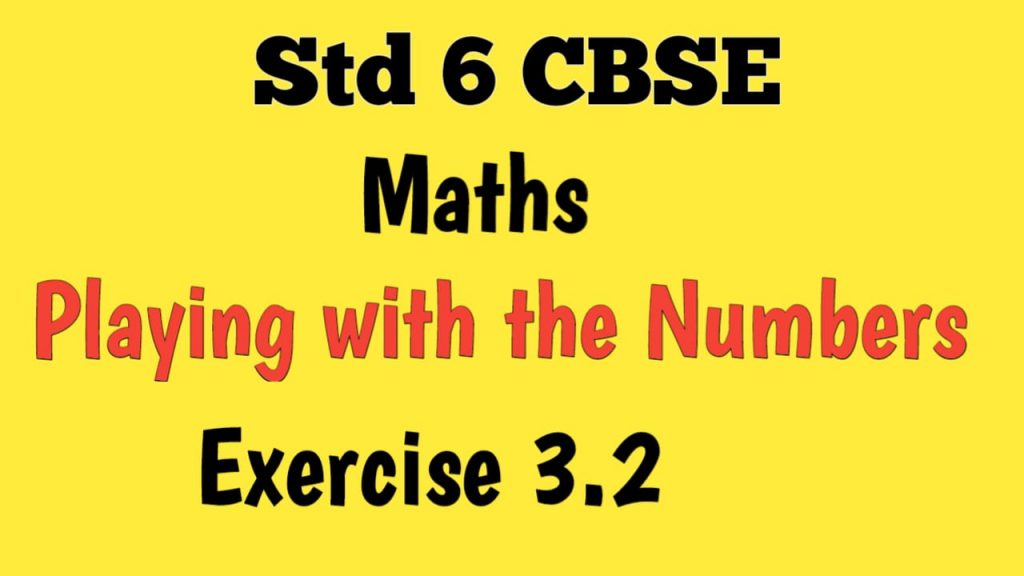Playing with Numbers
Exercise 3.2
Properties of Whole Numbers:
1). What is the sum of any two
a). odd numbers
b). even numbers
Answer:
1a). The sum of any two odd numbers is always an even number.
1b). The sum of any two even numbers is always an even number.
2). State whether the following statements are True or False:
(a) The sum of three odd numbers is even.
(b) The sum of two odd numbers and one even number is even.
(c) The product of three odd numbers is odd.
(d) If an even number is divided by 2, the quotient is always odd.
(e) All prime numbers are odd.
(f) Prime numbers do not have any factors.
(g) Sum of two prime numbers is always even.
(h) 2 is the only even prime number.
(i) All even numbers are composite numbers.
(j) The product of two even numbers is always even.
Answers:
(a) The sum of three odd numbers is even.
False.
(b) The sum of two odd numbers and one even number is even.
True.
(c) The product of three odd numbers is odd.
True.
(d) If an even number is divided by 2, the quotient is always odd.
False.
(e) All prime numbers are odd.
False.
(f) Prime numbers do not have any factors.
False.
(g) Sum of two prime numbers is always even.
False.
(h) 2 is the only even prime number.
True.
(i) All even numbers are composite numbers.
False.
(j) The product of two even numbers is always even.
True.
3). The numbers 13 and 31 are prime numbers. Both these numbers have the same digits 1 and 3. Find such pairs of prime numbers up to 100.
17 and 71, 37 and 73, 79 and 97.
4). Write down separately the prime and composite numbers less than 20.
| Prime Numbers | Composite Numbers |
| 2
3 5 7 11 13 17 19 |
4
6 8 9 10 12 14 15 16 18 20 |
5). What is the greatest prime number between 1 and 10?
The greatest prime number between 1 and 10 is 7.
6). Express the following as the sum of two odd primes.
(a) 44 (b) 36
(c) 24 (d) 18
Answers:
(a) 44 = 3 + 41; 13 + 31
(b) 36 = 5 + 31; 7 + 29; 13 + 23; 17 + 19
(c) 24 = 5 + 19; 7 + 17; 11 + 13
(d) 18 = 5 + 13; 7 + 11
7). Give three pairs of prime numbers whose difference is 2.
[Remark: Two prime numbers whose difference is 2 are called twin primes].
The pairs of twin prime numbers are as follows.
(3, 5); (5, 7); (11, 13); (17, 19); (29, 31); (43, 41); (59, 61); (71, 73)
8). Which of the following numbers are prime?
(a) 23 (b) 51
(c) 37 (d) 26
Answers:
(a) 23
Factors of 23 are 1 and 23.
It is a prime number.
(b) 51
Factors of 51 are 1, 3, 17 and 51.
It is not a prime number.
(c) 37
Factors of 37 are 1 and 37.
It is a prime number.
(d) 26
Factors of 26 are 1, 2, 13 and 26
It is not a prime number.
9). Write seven consecutive composite numbers less than 100 so that there is no prime number between them.
Seven consecutive composite numbers less than 100 so that there is no prime number between them are 90, 91, 92, 93, 94, 95, 96.
10). Express each of the following numbers as the sum of three odd primes:
(a) 21 (b) 31
(c) 53 (d) 61
Answers: (write any one of the answers).
(a) 21 = 3 + 5 +13; 3 + 7 + 11
(b) 31 = 3 + 5 + 23; 3 + 11 + 17
(c) 53 = 3 + 7 + 43; 3 + 13 + 37; 3 + 19 + 31; 7 + 11 + 13;
3 + 19 + 31; 5 + 7 + 41; 5 + 11+ 37; 5 + 17 + 31; 5 + 19 + 29;
7 + 13 + 23; 7 + 17 + 29
(d) 61 = 3 + 5 + 53; 3 + 11 + 47; 3 + 17 + 41; 5 + 13 + 43;
5 + 19+ 37
11). Write five pairs of prime numbers less than 20 whose sum is divisible by 5.
(Hint : 3+7 = 10)
2 + 3; 2 + 13; 3 + 7; 3 + 17; 7 + 13; 11 + 19 are the pairs of prime numbers less than 20 whose sum is divisible by 5.
12). Fill in the blanks :
(a) A number which has only two factors is called a prime number.
(b) A number which has more than two factors is called a composite number.
(c) 1 is neither prime nor composite number.
(d) The smallest prime number is 2.
(e) The smallest composite number is 4.
(f) The smallest even number is 2.
![]()
